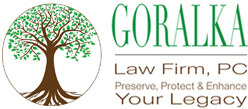High income individuals and business owners should update budgets to calculate what portion of their wages, retirement plan distributions or other income will be subject to the 50%+ top marginal tax brackets that affect most California taxpayers earning more than $400,000 per year. If you are earning more than $400,000 per year, we should move forward ASAP because it is much harder for us to give personal attention as we get deeper into the 4th quarter. We can still do 2015 income tax planning in December. However, our time is limited and we ask that you please let us know soon if you would like to explore your tax deduction options before the year end. Please call us at 916-440-8036 to schedule a year-end planning meeting.
Opportunities for attorneys increased dramatically in early 2013 when the President signed the
American Tax Relief Act of 2012 into law. While the demand for estate planning shrank when the estate tax exemption increased from $1 million per person to the new "permanent" exemption of more than $5 million per individual, the need for income tax planning grew substantially when the top marginal rates increased for most taxpayers. For 2016, the estate and gift tax exemption is expected to increase to 5.45 million dollars
Many individuals will now have top tax rates of more than 37 percent on capital gains and more than 50 percent on ordinary income unless financial planners provide solutions.
Impact of New Tax Rates
The impact of the new higher tax rates is evident when projecting retirement savings growth over 20 years. For example, a business owner funding a retirement plan with $500,000 over the next few years can expect the plan to generate more than $1,760,000 of tax-free income (if money grows at 6.5 percent and there are no taxes on contributions or withdrawals). If, however, the executive is married with income of more than $450,000, then marginal tax rates may be 39.6 percent at the federal level and 10.23 percent at the state level. Together, these rates reduce money going into Roth IRAs, retirement annuities, and related retirement investments by almost 50 percent. If the executive keeps the money in annuities or stock investments, there will likely be additional taxes when the funds are withdrawn. Even if withdrawals are taxed at capital gains rates instead of ordinary income rates, the Federal capital gains rate of 20 percent is often increased by the 3.8 percent surtax for couples earning more than $250,000, and further increased by state tax rates that approach or exceed 10% in major states like
California and
New York. It is therefore common to see capital gains taxes that consume more than one-third of gains. In the largest state (California), capital gains rates can exceed 37%.
To illustrate the impact of taxes, it is useful to look at how taxes reduce returns across time. Consider a client who has $500,000 of excess income (e.g., income not used for lifestyle expenses) this year or over the next few years. If the 50 percent rate on contributions applies along with the 38 percent rate on withdrawals, the $500,000 is worth only $662,287 in 30 years. On the other hand, if the client invests the $500,000 in vehicles that generate current tax deductions and avoid taxes on investment income and distributions the $500,000 can grow across 30 years to be worth more than $5,000,000. Would a client rather have a half a million of extra taxable income grow to $662,000 or $5,000,000?
Obviously, investments will perform better if there are no taxes on the contributions, accumulation, and withdrawals. Fortunately, American tax policy encourages the pre-tax funding of investments using a variety of planning instruments discussed on the following pages. Moreover, tax laws allow for the integration of legal, investment, and insurance tools to facilitate tax-free accumulation and distributions. As long as individuals are willing to make longer-term investments and properly integrate planning instruments, they can climb a pyramid with each higher level allowing for bigger tax deductions in the current tax-free, more tax efficient investment compounding, and larger tax-free income payments during years when funds are withdrawn.
Sorting through the different tax planning options may seem the herculean tasks; however, the pyramid diagram simplifies the decision process. The six levels of the pyramid graphic, explained below, illustrate how individuals are rewarded for advancing from traditional to more sophisticated strategies.
Level 1:
The bottom level on the pyramid depicts how most individuals receive their income. Their paychecks show heavy FICA, FUTA,
SUTA, and other payroll taxes as well as withholdings for state and federal taxes. As indicated on many paystubs, more than half of the income can be lost to taxes at Level 1. Moreover, after-tax investments in retirement vehicles can trigger additional taxes, as indicated down the right side of the pyramid below and the after-tax numbers on the above table.
Level 2:
Climbing the pyramid to Leve 2 affords individuals opportunities to invest in
ERISA qualified plans. Such plans include 401(k) plans as well 403(b)s, SIMPLE plans, profit-sharing plans and defined benefit plans. While employee deferrals used to fund qualified plans will still be subject to payroll taxes, the heavy state and federal income taxes are deferred until money comes out of the qualified plans. The tax-deferred growth in retirement plans has helped Americans accumulate more almost $25 trillion in retirement plan assets. Without advanced planning, this $25 trillion is all subject to ordinary income taxes during retirement or at death.
Level 3:
Business owners and highly compensated employees often want more tax benefits than qualified plans afford. Too often, the top-heavy rules limit the amount of contributions by highly compensated executives. To work around the ERISA restrictions, financial planners offer a variety of non-qualified deferred compensation plans. These include traditional deferred compensation plans involving salary and bonus deferrals as well as more sophisticated plans covered by 409(A) rules on deferred compensation. With the common
Supplemental Employee Retirement Plan ("SERP") arrangements. The employer must wait to receive the deduction until the employee receives the benefit.
Since 2004, the 409(A) regulations have increased the risk of current taxes applying to non-qualified deferred compensation plans, including restricted stock, phantom stock and performance share plans, as well as stock appreciation rights and long-term bonus or commission programs. Many executives have used these plans to accumulate substantial balances without realizing the full extent of the likely withdrawal taxes. Now these executives face much higher than expected taxes on their withdrawals because of the higher marginal rates in 2015. This is spurring growing interest in Levels 4 through 6 of the pyramid.
Level 4:
The Level 4 solutions include a variety of charitable planning instruments that allow for large income tax deductions when they are funded as well as tax-deferred growth on the plan balances. Moreover, the distributions may have only moderate withdrawal taxes. For example,
charitable remainder trusts (CRTs) can distribute tax-free or capital gains income. Gift annuities can pay out partially tax-free income by returning the initial investment capital as part of each payment. These charitable tools can be custom-designed for each individual to start retirement income when income is more needed or tax rates are lowest. For these reasons, the charitable tools at Level 4 can provide better bottom line benefits than those generated at levels 103.
Level 5:
Individuals focused on retirement security and income may reject level 4 solutions because "charity begins at home." Fortunately, there are charitable solutions such as
Super CLAT designed with the current low 7520 rate that can increase what goes to the donor throughout retirement. For substantial benefits from non-charitable tools, employers will often take deductions for a Section 162 plan or Section 79 plan. For example, a company can make pre-tax contributions of $500,000 to a section 79 plan so that an employee can receive tax-free income of nearly $1.1 million while also funding a tax-free death benefit for his or her heirs that may be more than $1 million.
Level 6:
Creative planners continue to find synergistic combinations of planning instruments that can provide benefits that exceed those illustrated in Level 5. For example, the Family Retirement Account™ ("FRA") leverages the benefits of universal life insurance using loans and a dynasty trust in order to convert taxable retirement income into tax-free cash flow and/or wealth transfers. Capital Split Dollar ("CSD") helps employers take income tax deductions for funding tax-free retirement and death benefits for key executives. An
employee Stock Ownership Plan ("ESOP") can provide tax-free build-up of assets. When the ESOP is combined with a charitable trust, the resulting "ChESOP" can produce both tax deductions in the early years and tax-free income in later years. For individuals with more charitable intent, a popular Level 6 strategy is the charitable LLC. $500,000 contributed can produce more than $2 million for family and charity. The family benefits can exceed those of the Section 79 plan while also giving individuals the satisfaction of redirecting tax money to their favorite charities.
While qualified attorneys opine that the above Level 6 strategies are within the letter and spirit of the tax code, the techniques may be too complicated for some individuals. Moreover, attorneys must consider a long list of legal, tax, and financial issues when integrating the components of the advanced planning tools. Failure to implement and monitor strategies correctly can create unnecessary audit risks. If the client has concerns about the ability of his or her team to maintain a Level 6 strategy across time, then simpler strategies at Levels 2 to 5 may be better.
Conclusion
New tax laws, such as the 409(A) rules passed several years ago and the American Tax Relief Act signed in 2013, have curtailed many popular planning strategies. Wise planners, like Hercules, find that each time a head is cut off the hydra, two new heads grow. The decline in the demand for estate tax planning is small compared to the big increase in the demand for income planning and retirement planning. Attorneys have immense opportunities to serve the tens of millions of present and prospective individuals who are stuck at Level 1 or Level 2 of the tax efficiency pyramid. As indicated above, there are compelling reasons and great financial rewards for the individuals who advance to Levels 3, 4, 5 and 6 in the tax efficient lifetime income planning process.
Our time is limited and we ask that you please let us know soon if you would like to explore your tax deduction options before the year end. Please call us at 916-440-8036 to schedule a year-end planning meeting.
These materials have been adapted from www.vfos.com/TaxPyramid with the permission of Tim Voorhees, JD, MBA. Tim Voorhees' planning teams have developed thousands of "blueprints" that align legal, tax, and financial strategies with the vision and values of wealth holders. These plans have helped clients redirect billions of dollars of tax savings to trusts that generate greater after-tax retirement income, bigger transfers to family and larger gifts to favorite charities. Tim regularly publishes articles in leading publications and speaks at conferences for many national organizations. To see a full bio, please visit www.TimVoorhees.com.
John Goralka is the lead attorney and founder of the Goralka Law Firm, P.C., and is an experienced Sacramento estate planning and tax planning lawyer.
For help in Sacramento with estate planning, business planning or tax planning, please contact our office.
![Sacramento Tax attorney]()


